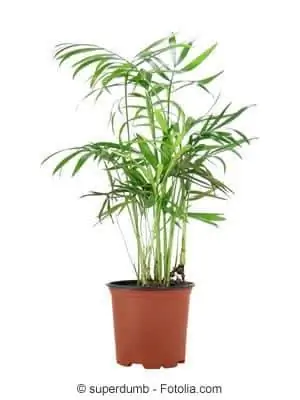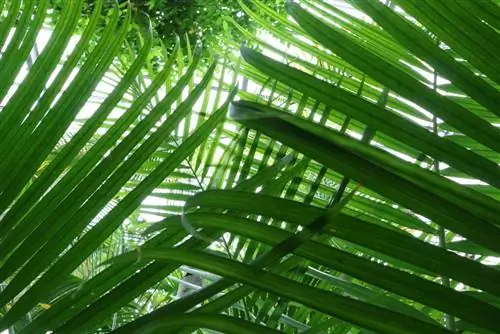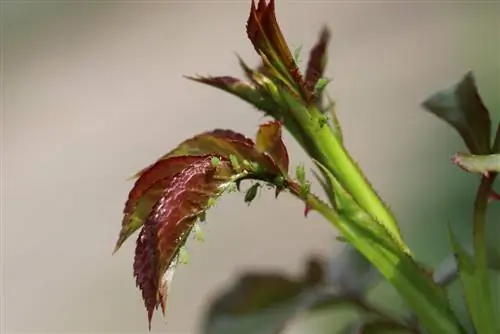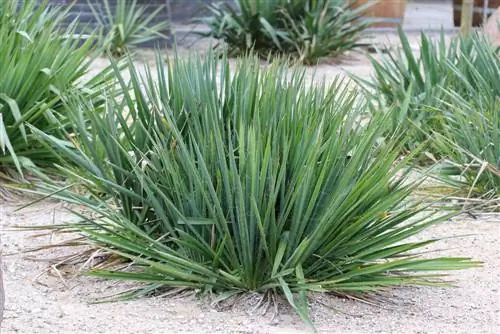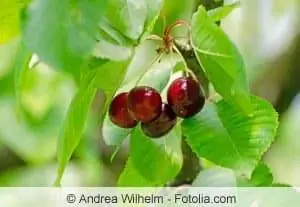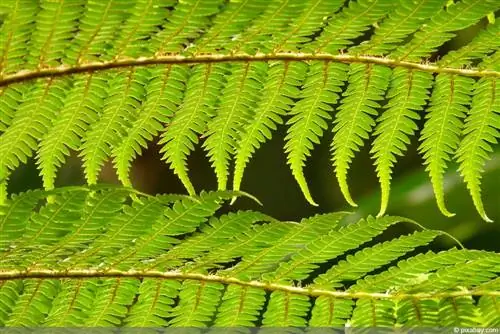- Author admin [email protected].
- Public 2023-12-17 03:39.
- Last modified 2025-01-24 12:45.
In popular parlance, palm trees are often referred to as the “princes of the plant kingdom”. Without a doubt they are, regardless of whether they are small in stature like the mountain palm, have fan-like leaves like the umbrella palm or have feathery foliage like the butia palm. Palm trees can even be kept in city apartments, where they refresh the atmosphere and noticeably emphasize the charisma of the interior. In addition to a location that is bright all day, many palm trees also need good humidity. We will introduce you to some easy-care palm trees for keeping indoors.
Mountain palm (Chamaedorea elegans)
The mountain palm is a widespread houseplant that adapts perfectly to living space conditions and can even bloom indoors. It remains quite small compared to the other palms, even though it can grow up to 5 m high as an understory plant in its native mountain forests of Central America. The mountain palm genus includes approximately 120 subspecies.
Plant shape
- cane-like, smooth trunk
- mostly pinnate leaves
- paniculate or simply branched, yellow flowers
- Flowers look similar to mimosa flowers
- Flowers sit under or between the leaves
Substrate
Mountain palms want to grow in permeable substrates that can even be slightly alkaline. This type of palm also tolerates slightly acidic soil.
Tip:
The mountain palm thrives and blooms best in hydroponics. However, the change should be made when the plant is still young. Their sensitive roots can be injured later.
Location
Since mountain palms don't like full sun, they will make do with even the shadiest place in the apartment, even if they would prefer a bright location with a light intensity of 700 lux. In autumn and winter, night temperatures at the location should not fall below 12 °C. Dry air does not harm it. However, a heavily heated room in winter has a detrimental effect on the mountain palm. In summer she can have a shady spot outside.
Watering and fertilizing
- water abundantly in summer
- keep the pot balls slightly moist in winter
- weekly liquid fertilizer in moderate concentration
- Fertilizing time March to July
Propagation
through seeds at high soil temperatures between 24 and 26 °C
Butia palm (Butia capitata)
The butia palm originally comes from the South American continent. This type of feather palm grows up to 5 m high. It is also colloquially called the jelly palm because its berries can be used to make delicious jelly.
Plant shape
- densely feathered, beautifully curved fronds
- Thorns sit at the base of a frond stem
- Remnants of dead palm fronds remain visible at the base of the plant
Substrate
The butia palm likes potting soil containing clay and only needs to be repotted every four years.
Location
A bright, cool location all year round is best suited for Butia capitata. In winter the room temperature should be no more than 10°C. For example, a rarely used guest room or a cold winter garden are ideal.
Watering and fertilizing
- likes moisture in the root area
- However, avoid waterlogging
- fertilize every 4 weeks in summer
- with liquid fertilizer
Propagation
- by sowing
- Germination time up to half a year
Kentia palm (Howea)
The Kentia palm, also often called Howea, is a well-known, easy-care and fairly slow-growing palm that comes from the Lord Howe Islands. There it can reach a height of 17 m. 100 years ago it was a real fashion palm. However, it has not lost any of its popularity to this day. It is a very popular houseplant. There are two subspecies: Howea forsteriana (max. height 15 m) and Howea belmoreana (max. height 8 to 10 m).
Plant shape
- spreading growth, especially Howea belmoreana
- elegant, slightly overhanging, feathery fronds
Substrate
Both types of Kentia like permeable substrate that can be slightly acidic. But hydroponics is not desired.
Location
The Kentia palm has few requirements for humidity and light. It should be placed slightly away from the window as it cannot tolerate full sunlight.
Watering and fertilizing
- water enough in summer
- less in winter
- Fertilizing with complete fertilizer on moist soil
- March to July
Propagation
- thrives by sowing fresh seeds
- Germination sometimes takes up to 9 months
Coconut palm (Cocos nucifera)
The coconut palm is native to all tropical sea coasts and is the most widespread crop. Almost all of their plant parts can be processed. At the age of 100 years, this feather palm can grow up to 30 m high in its homeland.
Plant shape
- slender, brown trunk
- Stem ends in a tuft with 20 to 30 feathers
- Feathers can grow up to 6 m long
- panicle-shaped inflorescences
- Inflorescences emerge from the leaf axils
Substrate
The coconut palm wants permeable substrate. For example, you can use garden soil and mix it with sand.
Location
The coconut palm loves warmth, but does not want full sun. A bright place all year round with summer temperatures around 20 °C is ideal. In winter the temperature should be 15 to 18 °C. Like the other palm trees, it likes high humidity.
Watering and fertilizing
- watering is abundant in summer
- fertilization is carried out every 14 days in summer with complete fertilizer
- water less in winter and do not fertilize
Propagation
- by sowing
- only half of the coconut is used
- place horizontally in the pot and keep moist and warm
- Germination time 4 to 6 months
Coconut trees (Microcoelum weddelianum)
The coconut tree was previously incorrectly assigned to the genus Cocos. The delicate feather palm comes from the tropics of Brazil, only grows up to 1.5 m high and the trunk is only 3 cm thick.
Plant shape
- up to 1 m long fronds
- pinnate leaves sitting in pairs on the midrib
- blue-white color on the underside of the feathers
- Inflorescences produce orange-red fruits
Substrate
The coconut tree also likes a permeable substrate.
Location
Not in direct sunlight, but always keep it bright all year round. Ambient temperatures of 18 °C are ideal.
Watering and fertilizing
- Keep substrate moist at all times
- Administer complete fertilizer every 3 weeks in summer
Propagation
- by sowing
- Germination time 2 months
Umbrella palm (Livistona)
The Livistona is a beautiful fan palm. There are 24 species that come from Malaysia, Southeast Asia, New Guinea and Australia. However, 3 species are only suitable as houseplants: Livistona australis, Livistona chinensis and Livistona rotundifolia.
Plant shape
- stems covered in thorns
- L. australis and L. rotundifolia: round fans
- l. chinensis: elliptical fans
Substrate
The substrate should be well-drained. L. rotundifolia likes sandy soil.
Location
The umbrella palm likes a bright place with moderate temperatures. In winter, temperatures between 14 and 18 °C are sufficient.
Watering and fertilizing
- water regularly
- if the palm tree is warmer, water more
- limit watering in winter
- Fertilize every 14 days in summer
Propagation
- by sowing
- Germination time up to 4 months
High humidity
Palm trees generally like high humidity. Therefore, you can regularly spray the palm fronds with soft water or gently wipe them with a damp cloth. This will help you avoid pest infestation, especially in the winter months when the air in the room becomes drier due to heating. If your palm trees are not too big, they can be showered in the bathtub every now and then along with other houseplants.
Tip:
If the palm trees cannot be provided with sufficient humidity, the lack of moisture can be compensated for with a planter filled with water. However, the palm tree should not be constantly in water!
Waterlogging
Palm trees like high humidity and need a lot of water in summer. However, they cannot tolerate waterlogging as their roots can then rot very quickly!
Diseases and pests
If the air in the room is too dry, spider mites, red spiders or mealy bugs can settle on the fronds. The palm trees then quickly become unsightly and their frond tips turn yellow or brown. However, with sufficient humidity of 40%, which is desired by almost all palm trees, you can prevent pest infestation. If you have discovered pests, you should use biological means and not use aggressive chemical means.
Conclusion
All types of palm trees described can basically be cared for without much effort if you offer them a bright place, with a few exceptions like the mountain palm. Palm trees do not like direct sunlight. If you water and fertilize the palm trees regularly, you will be able to enjoy these pretty creatures for a very long time. If you don't like liquid palm fertilizer or if regular fertilization is too time-consuming, you can use slow-release fertilizer at the beginning of summer. The older fronds of palm trees regularly die. That's why you can cut off these fronds without remorse.

